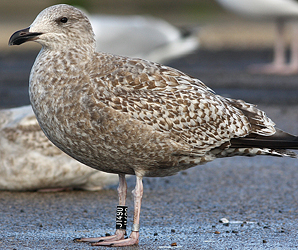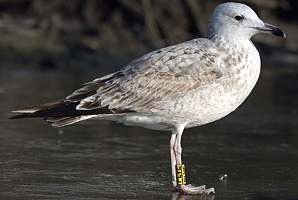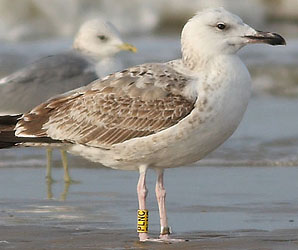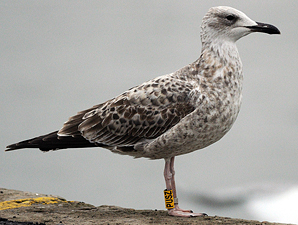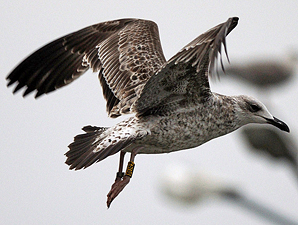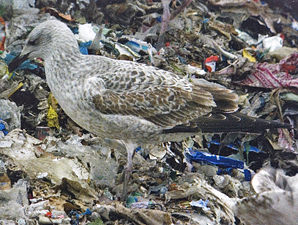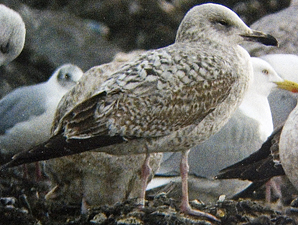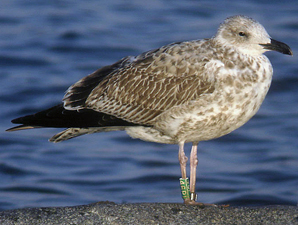 Larus cachinnans
Larus cachinnans
(last update:
Greg Neubauer
Marcin Przymencki
Albert de Jong
Mars Muusse
 sub-adult cachinnans: July
sub-adult cachinnans: July
In 2011, Chris Gibbins, Grzegorz Neubauer and Brian Small published two extensive papers in Britsih Birds, dealing with Caspian Gull. Below, you will find the content of the second paper "phenotypic variability and the field characteristics of hybrids".
The full title reads: From the Rarities Committee's files - Identification of Caspian Gull. Part 2: phenotypic variability and the field characteristics of hybrids, by Chris Gibbins, Grzegorz Neubauer and Brian Small, IN: BB 104/2011. ORDER PAPER COPY!
"we" in the text below refers to the original authors. If any errors occur in this text, please let me know and mail to marsmuusseatgmaildotcom.
PART 1: ABSTRACT & INTRODUCTION
PART 2: APPROACH
PART 3: ADULT BIRDS AND FIRST WINTER BIRDS
PART 4: DATA ANALYSIS
PART 5: VARIABILITY IN PLUMAGE (OF ADULTS)
PART 6: IDENTIFICATION OF FIRST WINTER BIRDS
BELOW: PART 7 OF THE PAPER: EXTENT OF POST-JUVENILE MOULT
Identification of Caspian Gull. Part 2: phenotypic variability and the field characteristics of hybrids
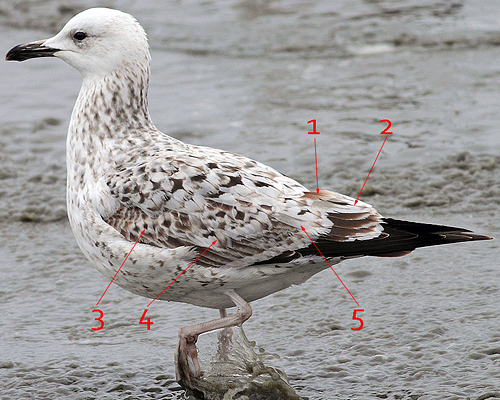
Larus cachinnans 2cy, 14 March 2012, Texel, the Netherlands. Picture: Herman Bouman. Picture, with arrows to explain post-juvenile moult (2nd gen wing-coverts & tertials). Click image for details. Scorings as per table 2.
Variability in extent of the post-juvenile moult
Moult data indicate that it would be extremely unusual to find a Caspian Gull after October of its first calendar-year with anything more than one or two first-generation scapulars remaining. The extent of the post-juvenile scapular moult varied considerably in the sample of Herring Gulls, however, which probably reflects the mixture of both argenteus (more extensive moult) and argentatus (little or no moult) in the sample. The extent of moult in the coverts and tertials differed considerably among Caspian Gulls (ranging from none to extensive), but was extremely consistent in the Herring Gull sample: just one bird showed any sign of covert or tertial moult, having two new inner median coverts. Thus, while a 1W with new wing-coverts or tertials is most likely to be a Caspian (or Yellow-legged) Gull, a bird with a completely first-generation wing could be any one of these species.
Multivariate analyses and the character of hybrid birds
Fig. 8 shows summary information on the total scores for sample 1W birds. Despite the variability of individual trait scores, as discussed above, the sum values for Caspian were consistently lower than those for Herring Gull, with no overlap in the distribution of scores. The mean value for Caspian Gull was 18, with 95% of birds having scores between 12 and 24. The highest score recorded by any single Caspian was 25. Thus, if sample data are representative, they indicate that any bird with a score greater than 25 should not be a Caspian Gull. The lowest score of any Herring Gull in the sample was 29, with 95% of the Herring Gulls having scores between 30 and 36. Scores for hybrids were intermediate between the parental species, with overlap at the upper (i.e. with Herring) and lower (with Caspian) ends.
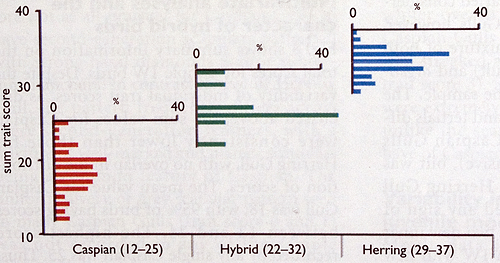
Fig. 8. Sum trait scores for first-winter Caspian Larus cachinnans and Herring Gulls L. argentatus, and hybrids. Scores are calculated by summing individual trait score values. The figure shows the percentage of individuals in the sample with a given sum value. Numbers in parentheses are the minimum and maximum values recorded.

Fig. 9. PCA biplot showing sample first-winter Herring Larus argentatus and Caspian Gulls L. cachinnans and a number of proven and suspected hybrids. Each circle represents a sample bird. Together, axes l and 2 capture 73.4% of the variance in the sample data. The polygon to the right groups sample Caspian Gulls, while that to the left groups Herring Gulls. Hybrid birds are highlighted in red; numbers relate to plates that show examples of some of these hybrids. Codes for traits are: Bill=bill length:depth ratio, Pproj=length of primary projection, TM=extent of tertial moult, GCovM=extent of greater-covert moult, MCovM=extent of median-covert moult, ScapM=extent of scapular moult, GCovPat=greater-covert pattern, Tpat=tertial pattern, Legs=leg length,Vbul=presence of ventral bulge, Darkness=extent of streaking on head and body, and ScapP is the pattern on second-generation scapulars.
Fig. 9 shows the biplot resulting from the PCA analysis of 1W birds. There is clear separation between Herring and Caspian Gulls, with this separation occurring across component 1. Importantly, there is no overlap between the two species in terms of their positions on axis 1. There is considerable individual variation, this being more pronounced in Caspian Gull than Herring. This intraspecitic variability is evident most obviously by the much larger space occupied by the polygon which groups the sample cachinnans.
Some of the traits we analysed were useful for separating the two species, while others were more responsible for the intraspecific variability. Those traits whose arrows lie on or close to (i.e. more parallel with) axis 1 are responsible for the separation of birds in this horizontal dimension, and consequently for separating Herring from Caspian Gull. These traits are, in order of proximity to axis 1 (and hence importance in separating birds in this dimension):
(i) bill length:depth ratio;
(ii) extent of scapular moult;
(iii) greater-covert pattern; and
(iv) primary projection.
Conversely, arrows for some traits (e.g. extent of covert and tertial moult and the pattern of second-generation scapulars) point away from axis 1. The position of these arrows relative to axis 1 indicates that they are not important for separating the two species but the fact that they are long, relative to those of the other traits, indicates that they contribute importantly to the variability observed in the sample. Most of the spread in the Caspian Gull polygon occurs in approximately the vertical and/or northeast-southwest dimension. This dimension corresponds most closely to the covert and tertial moult traits. There is also some spread in the Caspian Gulls in a northwest-southeast dimension, a dimension represented by long arrows for scapular pattern and plumage darkness.
Overall, the PCA indicates that much of the variability in Caspian Gulls relates to differences in the extent of post-juvenile moult, scapular patterns and overall darkness. It is notable that the arrows for leg length and the presence of a ventral bulge do not lie close to axis 1 and are rather short. This indicates that these features are of little use in differentiating between Caspian and Herring Gulls; this is borne out by the overlap apparent in table 3 and table 4.
The positions of known and suspected hybrids included in the analysis are highlighted in red in fig. 9; examples of these are shown in plates 423, 424, 46P1, 7P48, 427, 795P, 429, and their phenotypic characteristics are discussed in the respective captions. In general, most of these show an odd combination of traits that make them look like neither parent (plates 423, 424, 46P1). Most of the F1 hybrid birds occupied intermediate space on PCs 1 and 2. Two backcrosses are extremely troublesome as they sit within the core of the space occupied by pure Herring Gulls. They look very similar to a Herring Gull (e.g. plate 429) and without the evidence provided by the ring would most likely be overlooked as that species. Overall, the PCA results support the evidence from the trait sum scores (fig. 8), which indicate that some individuals of mixed parentage are not separable with confidence.
 2CY presumed hybrid Caspian x Herring Gull, April 2009, Riga, Latvia. Picture: Chris Gibbins. Ringed as a chick in a colony in eastern Lithuania where c. 50% of pairs are mixed, though its parents are uncertain. It occupies phenotypic space (fig. 9) that fits neither pure Caspian nor pure Herring Gull and its overall trait score of 26 reflects this. In the field it looked noticeably bulky, with a robust head and bill and relatively short legs. |
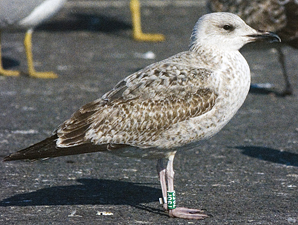 2CY backcross or F2 hybrid from central Poland, February 06 2006, Chioggia, Italy. Picture: Marco Basso. Father known as hybrid Caspian x Herring, mother unknown. Ringed as a chick on May 20 2005, photographed on the Adriatic coast in Italy, where it spent its first winter It occupies space on the PCA biplot (fig. 9) which is distant from any Caspian Gull and outside the space occupied by Herring Gull. Its trait score is 27 - too high for Caspian and below that of any pure Herring. |
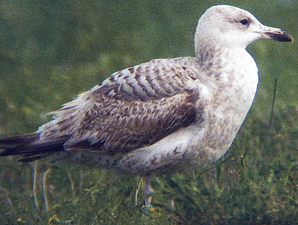 2CY backcross or F2 hybrid Caspian x Herring Gull, April 19 2007, Wloclawek, Poland. Picture: Grzegorz Neubauer. Ringed as a chick on May 20 2006 at Wloclawek, mother a hybrid, father unknown. Although it is rather pale and has a slim bill, this bird is inseparable from Herring Gull with any confidence. PCA (fig. 9) indicates that, phenotypically, it sits in the space occupied by pure Herring Gull, with a trait score of 30. |
 Juvenile Caspian Gull, Poland, July 16 2010. Picture: E. M. Sowa. Ringed in the Caspian Gull core range in Ukraine in June 2010. It is in very fresh juvenile plumage and thus extremely dark on the head and body; broad white notches on the greater coverts (score 3) are more indicative of Herring, but the plumage is otherwise typical for fresh juvenile Caspian. This bird flew c. 300 km to the northwest a month after it was ringed. |
END OF PART 7
CONTINUE PART 8: Underwing pattern in 1W Caspian Gull
 Larus cachinnans 2CY-5CY UKK T-001874 May 2010 - July 2013, Windheim & Deponie Pohlsche Heide - Minden, Germany.
Picture: Armin Deutsch.
Larus cachinnans 2CY-5CY UKK T-001874 May 2010 - July 2013, Windheim & Deponie Pohlsche Heide - Minden, Germany.
Picture: Armin Deutsch. 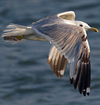 Larus cachinnans PHVL 3CY-4CY, October 2013 - July 2014, Almere, the Netherlands. Picture: Karel Mauer & Eric Roeland.
Larus cachinnans PHVL 3CY-4CY, October 2013 - July 2014, Almere, the Netherlands. Picture: Karel Mauer & Eric Roeland. Larus cachinnans 4CY V560 July 19 2009, Dumpiai dump, Klaipeda, Lithuania. Picture: Vytautas Pareigis.
Larus cachinnans 4CY V560 July 19 2009, Dumpiai dump, Klaipeda, Lithuania. Picture: Vytautas Pareigis. 